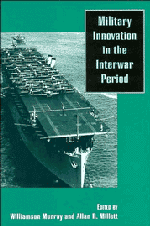Book contents
- Frontmatter
- Contents
- Acknowledgments
- Introduction
- 1 Armored warfare: The British, French, and German experiences
- 2 Assault from the sea: The development of amphibious warfare between the wars – the American, British, and Japanese experiences
- 3 Strategic bombing: The British, American, and German experiences
- 4 Close air support: The German, British, and American experiences, 1918–1941
- 5 Adopting the aircraft carrier: The British, American, and Japanese case studies
- 6 Innovation ignored: The submarine problem – Germany, Britain, and the United States, 1919–1939
- 7 From radio to radar: Interwar military adaptation to technological change in Germany, the United Kingdom, and the United States
- 8 Innovation: Past and future
- 9 Patterns of military innovation in the interwar period
- 10 Military innovation in peacetime
- Index
6 - Innovation ignored: The submarine problem – Germany, Britain, and the United States, 1919–1939
Published online by Cambridge University Press: 05 August 2012
- Frontmatter
- Contents
- Acknowledgments
- Introduction
- 1 Armored warfare: The British, French, and German experiences
- 2 Assault from the sea: The development of amphibious warfare between the wars – the American, British, and Japanese experiences
- 3 Strategic bombing: The British, American, and German experiences
- 4 Close air support: The German, British, and American experiences, 1918–1941
- 5 Adopting the aircraft carrier: The British, American, and Japanese case studies
- 6 Innovation ignored: The submarine problem – Germany, Britain, and the United States, 1919–1939
- 7 From radio to radar: Interwar military adaptation to technological change in Germany, the United Kingdom, and the United States
- 8 Innovation: Past and future
- 9 Patterns of military innovation in the interwar period
- 10 Military innovation in peacetime
- Index
Summary
The submarine is not an honest weapon. It suggests the foot pad, the garotte, and the treacherous knife dug in an opponent's back when he is off guard.
Sir Archibald Hurd, 1902The submarine defies neutral sentiment. To its advocates, it constitutes a cheap but effective counterthreat to superior surface forces, the weapon of the poorer against the richer power. The brotherhood of submariners often views itself as a “private navy,” hides its arcane mysteries from outsiders, and defends in every sense its “silent service.” To adversaries, the submarine is an unfair and unsportsmanlike weapon, a weapon of piracy and barbarity. Both positions appeared as early as the Hague Conference in 1899; Germany, Britain, and Russia were willing to ban underwater warships – albeit, on condition of universal prohibition, but France and the United States refused to abolish what they considered the cheapest means available to reduce British naval superiority.
Karl Lautenschläger has identified five general principles that govern the use of submarines in naval warfare. First, underwater warships possess no inherent immunity against countermeasures. Although they are difficult to find and largely invulnerable while submerged, submarines are open to attack once they disclose their presence by attacking surface vessels. Second, navies have trouble integrating submarines into existing force structures and operational concepts. In most cases, navies have found it difficult to define a specific mission for the submersible.
- Type
- Chapter
- Information
- Military Innovation in the Interwar Period , pp. 227 - 264Publisher: Cambridge University PressPrint publication year: 1996
- 2
- Cited by

